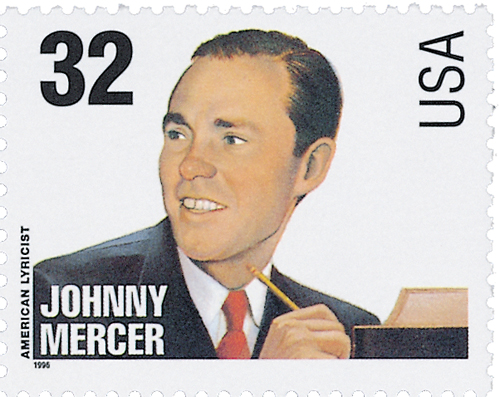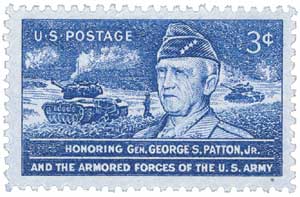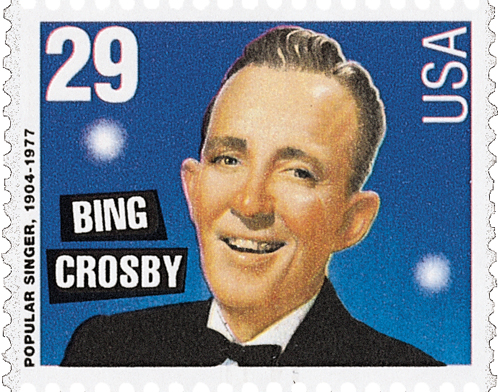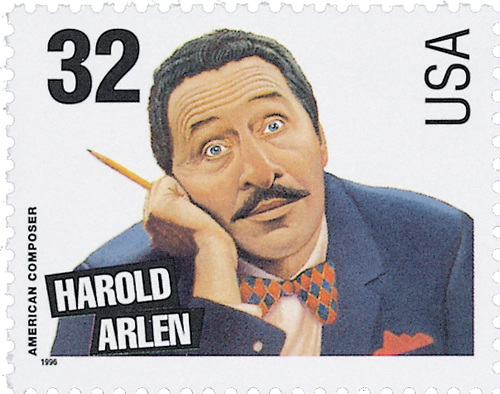
# 3101 - 1996 32c Songwriters: Johnny Mercer
US #3101
1996 Johnny Mercer
- One of four legendary Songwriters
- 8th pane in the Legends of Music series
- Stamps were issued on same day as Big Band Leaders stamps in same series
Stamp Category: Commemorative
Set: Songwriters, American Music series
Value: 32¢, First-Class mail rate
First Day of Issue: September 11, 1996
First Day City: New York, New York
Quantity Issued: 23,025,000
Printed by: Ashton-Potter (USA) Ltd.
Printing Method: Lithographed
Format: Panes of 20 (4 across, 5 down) from plates of 120 (12 across, 10 down)
Perforations: 11.1 x 11
Why the stamp was issued: The five stamps in the Songwriters set honor two talented composers - Harold Arlen and Hoagy Carmichael - and two lyricists – Johnny Mercer and Dorothy Fields.
About the stamp design: The portraits of the four big band leaders were made by Bill Nelson, who works in colored pencils on recycled charcoal paper. He had previously designed album covers for big band recordings compiled by Time-Life Records.
First Day City: The set of songwriters stamps was dedicated at Shubert Alley in New York City. The Big Band Leaders stamps from the same series were issued at the same time. It kicked off the US Postal Service’s American Music Stamp Festival 1996. Family members of the people featured on the stamps were present at the ceremony.
About the Legends of American Music Series: Honored as part of the Legends of American Music series in 1996 were four of the most popular and successful lyricists and composers of all time - Harold Arlen, Johnny Mercer, Dorothy Fields, and Hoagy Carmichael. The talents of these individuals gave us such popular songs as "Over the Rainbow," "Jeepers Creepers," "I'm in the Mood for Love," and "Stardust."
The Legends of American Music Series debuted on January 8, 1993, and ran until September 21, 1999. More than 90 artists are represented from all styles of music: rock ‘n’ roll, rhythm and blues, country and western, jazz and pop, opera and classical, gospel and folk. In addition to individual singers and Broadway musicals, subjects include band leaders, classical composers, Hollywood songwriters and composers, conductors, lyricists, and more. The Legends of American Music Series was a huge advancement for diversity because it honored many Black and female artists.
Birth of Johnny Mercer

John Herndon Mercer was born on November 18, 1909, in Savannah, Georgia. A lyricist, songwriter, and singer, Mercer wrote more than 1,500 songs during his career, many of which were popularized in films and on Broadway.
Mercer grew up with a natural appreciation for music. His grandmother said he would hum songs when he was six months old, and both of his parents sang to him. The family also had a summer home surrounded by mossy trees and saltwater mosses that would later inspire some of Mercer’s songs.

Mercer began singing in a choir when he was six. By the time he was 12, he memorized almost every song he heard and wanted to know more about the people who wrote them. At one point, Mercer hoped to become a composer, but he struggled to read musical scores and used his own notation system. He also played the trumpet and piano, but found his real talents lied in writing lyrics and singing. Mercer was greatly influenced by the blues and jazz singers of the day, including Ma Rainey, Bessie Smith, and Louis Armstrong.

Mercer attended a boarding school in Virginia where he was part of the literary and poetry societies. He also experimented with songwriting, with such tunes as “Sister Susie, Strut Your Stuff.” Mercer intended to go to Princeton, but had to help with his father’s struggling business. When he grew bored with that, he moved to New York in 1928. He found work as a bit actor and spent lots of time writing songs and singing. He passed one of these songs to Eddie Cantor who encouraged him to keep writing. And his girlfriend’s father, a music executive, helped him publish his first song.

The following year, Mercer went to California to work on lyrics for the musical Paris in the Spring. Returning to New York, Mercer found a job as a staff lyricist at Miller Music, giving him a stable income. He also made his recording debut singing with Frank Trumbauer’s Orchestra and apprenticed with Yip Harburg on Americana. Mercer was then paired with Hoagy Carmichael and the pair wrote “Lazybones,” which became a hit one week after it was released.

In 1935, Mercer moved to Hollywood to write songs for and appear in films. His first was the musical Old Man Rhythm, followed by To Beat the Band. Mercer then wrote “I’m an Old Cowhand from the Rio Grande” for the Bing Crosby film Rhythm on the Range. That song was well-received and established Mercer as an in-demand lyricist. He followed that with “Too Marvelous for Words,” “Hooray for Hollywood,” Jeepers Creepers,” and “You Must Have Been a Beautiful Baby.” When he wasn’t writing, Mercer also sang – he wrote and performed several songs with Bing Crosby.

Mercer scored another hit in 1939 with “And the Angels Sing,” a title that was later inscribed on his tombstone. Mercer then began working with the Camel Caravan radio show and wrote more hits – “You Ought to be in Pictures,” “Day In, Day Out,” and “Fools Rush In.” At one point five of the top ten songs on Your Hit Parade were Mercer tunes.

In the 1940s, Mercer began working with Harold Arlen. The pair scored several hits including “Blues in the Night,” “One for My Baby (and One More for the Road),” “Ac-Cent-Tchu-Ate the Positive,” “That Old Black Magic,” and “Come Rain or Come Shine.” In 1946, Mercer earned the first of four Academy Awards for Best Song for “On the Atchison, Topeka and the Santa Fe,” for the film The Harvey Girls. Mercer also founded Capitol Records, releasing his own music and the work of others.

In the 1950s, Mercer wrote songs for the films Seven Brides for Seven Brothers and Merry Andrew and the musicals Top Banana, Li’l Abner, and Saratoga. Hit songs of the era included “The Glow-Worm,” “Something’s Gotta Give,” “Moon River,” “Charade,” “I Wanna Be Around,” and “Summer Wind.”
In 1969, Mercer helped found the Songwriter’s Hall of Fame and served as its first president. He did on June 25, 1976, suffering from an inoperable brain tumor. Four years later the Songwriters Hall of Fame created the Johnny Mercer Award as its highest honor.
US #3101
1996 Johnny Mercer
- One of four legendary Songwriters
- 8th pane in the Legends of Music series
- Stamps were issued on same day as Big Band Leaders stamps in same series
Stamp Category: Commemorative
Set: Songwriters, American Music series
Value: 32¢, First-Class mail rate
First Day of Issue: September 11, 1996
First Day City: New York, New York
Quantity Issued: 23,025,000
Printed by: Ashton-Potter (USA) Ltd.
Printing Method: Lithographed
Format: Panes of 20 (4 across, 5 down) from plates of 120 (12 across, 10 down)
Perforations: 11.1 x 11
Why the stamp was issued: The five stamps in the Songwriters set honor two talented composers - Harold Arlen and Hoagy Carmichael - and two lyricists – Johnny Mercer and Dorothy Fields.
About the stamp design: The portraits of the four big band leaders were made by Bill Nelson, who works in colored pencils on recycled charcoal paper. He had previously designed album covers for big band recordings compiled by Time-Life Records.
First Day City: The set of songwriters stamps was dedicated at Shubert Alley in New York City. The Big Band Leaders stamps from the same series were issued at the same time. It kicked off the US Postal Service’s American Music Stamp Festival 1996. Family members of the people featured on the stamps were present at the ceremony.
About the Legends of American Music Series: Honored as part of the Legends of American Music series in 1996 were four of the most popular and successful lyricists and composers of all time - Harold Arlen, Johnny Mercer, Dorothy Fields, and Hoagy Carmichael. The talents of these individuals gave us such popular songs as "Over the Rainbow," "Jeepers Creepers," "I'm in the Mood for Love," and "Stardust."
The Legends of American Music Series debuted on January 8, 1993, and ran until September 21, 1999. More than 90 artists are represented from all styles of music: rock ‘n’ roll, rhythm and blues, country and western, jazz and pop, opera and classical, gospel and folk. In addition to individual singers and Broadway musicals, subjects include band leaders, classical composers, Hollywood songwriters and composers, conductors, lyricists, and more. The Legends of American Music Series was a huge advancement for diversity because it honored many Black and female artists.
Birth of Johnny Mercer

John Herndon Mercer was born on November 18, 1909, in Savannah, Georgia. A lyricist, songwriter, and singer, Mercer wrote more than 1,500 songs during his career, many of which were popularized in films and on Broadway.
Mercer grew up with a natural appreciation for music. His grandmother said he would hum songs when he was six months old, and both of his parents sang to him. The family also had a summer home surrounded by mossy trees and saltwater mosses that would later inspire some of Mercer’s songs.

Mercer began singing in a choir when he was six. By the time he was 12, he memorized almost every song he heard and wanted to know more about the people who wrote them. At one point, Mercer hoped to become a composer, but he struggled to read musical scores and used his own notation system. He also played the trumpet and piano, but found his real talents lied in writing lyrics and singing. Mercer was greatly influenced by the blues and jazz singers of the day, including Ma Rainey, Bessie Smith, and Louis Armstrong.

Mercer attended a boarding school in Virginia where he was part of the literary and poetry societies. He also experimented with songwriting, with such tunes as “Sister Susie, Strut Your Stuff.” Mercer intended to go to Princeton, but had to help with his father’s struggling business. When he grew bored with that, he moved to New York in 1928. He found work as a bit actor and spent lots of time writing songs and singing. He passed one of these songs to Eddie Cantor who encouraged him to keep writing. And his girlfriend’s father, a music executive, helped him publish his first song.

The following year, Mercer went to California to work on lyrics for the musical Paris in the Spring. Returning to New York, Mercer found a job as a staff lyricist at Miller Music, giving him a stable income. He also made his recording debut singing with Frank Trumbauer’s Orchestra and apprenticed with Yip Harburg on Americana. Mercer was then paired with Hoagy Carmichael and the pair wrote “Lazybones,” which became a hit one week after it was released.

In 1935, Mercer moved to Hollywood to write songs for and appear in films. His first was the musical Old Man Rhythm, followed by To Beat the Band. Mercer then wrote “I’m an Old Cowhand from the Rio Grande” for the Bing Crosby film Rhythm on the Range. That song was well-received and established Mercer as an in-demand lyricist. He followed that with “Too Marvelous for Words,” “Hooray for Hollywood,” Jeepers Creepers,” and “You Must Have Been a Beautiful Baby.” When he wasn’t writing, Mercer also sang – he wrote and performed several songs with Bing Crosby.

Mercer scored another hit in 1939 with “And the Angels Sing,” a title that was later inscribed on his tombstone. Mercer then began working with the Camel Caravan radio show and wrote more hits – “You Ought to be in Pictures,” “Day In, Day Out,” and “Fools Rush In.” At one point five of the top ten songs on Your Hit Parade were Mercer tunes.

In the 1940s, Mercer began working with Harold Arlen. The pair scored several hits including “Blues in the Night,” “One for My Baby (and One More for the Road),” “Ac-Cent-Tchu-Ate the Positive,” “That Old Black Magic,” and “Come Rain or Come Shine.” In 1946, Mercer earned the first of four Academy Awards for Best Song for “On the Atchison, Topeka and the Santa Fe,” for the film The Harvey Girls. Mercer also founded Capitol Records, releasing his own music and the work of others.

In the 1950s, Mercer wrote songs for the films Seven Brides for Seven Brothers and Merry Andrew and the musicals Top Banana, Li’l Abner, and Saratoga. Hit songs of the era included “The Glow-Worm,” “Something’s Gotta Give,” “Moon River,” “Charade,” “I Wanna Be Around,” and “Summer Wind.”
In 1969, Mercer helped found the Songwriter’s Hall of Fame and served as its first president. He did on June 25, 1976, suffering from an inoperable brain tumor. Four years later the Songwriters Hall of Fame created the Johnny Mercer Award as its highest honor.












